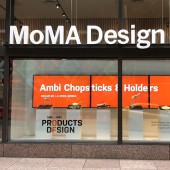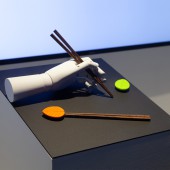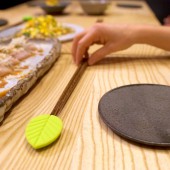Ambi Chopsticks & Holders Utensil by Oscar de la Hera Gomez |
Home > Winners > #78370 |
 |
|
||||
| DESIGN DETAILS | |||||
| DESIGN NAME: Ambi Chopsticks & Holders PRIMARY FUNCTION: Utensil INSPIRATION: On a warm summer night in London, my brother entertained my mother and I through a japanese toothpick, whose design told a story of the values that eastern societies place on minimalism, hygiene and sustainability. In particular, what stood out the most was the how the toothpicks body broke at its end to serve as a rest - allowing individuals to reuse the artifact throughout the meal. UNIQUE PROPERTIES / PROJECT DESCRIPTION: The Ambi Chopsticks and Holders is a set of chopsticks which resembled the twigs of a tree. Each chopstick set comes with a silicone leaf which serves three purposes, to help individuals identify which set is theirs, to hold the chopsticks together and to double up as a rest - allowing individuals to enjoy conversation during a meal. 50% of all royalties are donated to a reforestation cause. OPERATION / FLOW / INTERACTION: The Ambi Chopsticks and Holders presents itself as a set of branches held together by a leaf with the purpose of representing its mission, to reconstruct the environment, and to raise awareness that 80 billion single use chopsticks are disposed of every year. Ambi's "branches" form chopsticks, made from wendge wood and whose engineering properties ensure a theoretical infinite product lifetime on the S-N curve. This was an intentional material design decision if we are to replace disposable items with everlasting ones. The leaf that holds the branches together serves four purposes: A. To help individuals identify which set is theirs B. To hold the chopsticks together, preventing them from being separated and lost. C. To elevate the chopsticks of the table as they rest before the meal, as symbol of hygiene. D. To serve as a chopstick rest, allowing individuals to enjoy conversation during a meal. Each of these purposes was designed with a respective element of hygiene: A. To ensure a set can be associated with a specific user B. To create a behaviour that removes the mental toll of finding loose chopsticks C & D. To reduce contact with external surfaces PROJECT DURATION AND LOCATION: The project started in December 2015 and ended in April 2018 when in New York and was exhibited on the front windows of the MoMA Store in April 2018. |
PRODUCTION / REALIZATION TECHNOLOGY: The Ambi Chopsticks & Holders was prototyped creating a model using Solidworks, 3D printing the model in ABS and finishing it using resin and spray paint to deliver a photo-realistic finish. The final product was mass produced in China out of Wenge Wood and Silicone. SPECIFICATIONS / TECHNICAL PROPERTIES: 5h x 2w x 1.5"d. TAGS: Chopsticks, Sustainability, Reusable, Wood, Silicone, Organic RESEARCH ABSTRACT: To gain a deeper understanding of what makes a good set of chopsticks, I interviewed over 20 users from my target audience, aged 25-42, from which the following insights were gained: 1. Most individuals do not buy expensive chopsticks as they get lost. This insight resulted in the leaf holding the chopsticks together. 2. Foods that require chopsticks are often heavy in oils and require deep cleaning, as a result the chopsticks must include a layer of protection, ideally lacquer, to ensure longevity. 3. Eastern cultures place hygiene very highly and as a result, the set should provide a sense of hygiene across a meal. This insight resulted in the leaf protecting the tips of the chopsticks rather than the ends, as well as elevating the chopsticks off the table before and during a meal. Additionally, to gain an understanding on the environmental impact, I researched articles and reports from over 10 credible institutions including the New York Times, the Washington Post, Greenpeace, the World Wildlife foundation and the United Nations. From these sources the following learning were gained: 1. 20 million trees are chopped down every year to produce 80 billion disposable chopsticks. 2. Eastern government considered this a problem and are now promoting individuals carrying their own chopsticks. 3. Greenpeace had created a campaign to raise awareness on how many trees are torn down every year. CHALLENGE: The greatest psychological challenge that I faced was "what will be of my second commercial success?". Having won a MoMA pitch a year earlier, I made a conscious decision of to deliver something that would prove that I could design products within a wide spectrum to a high standard. Give that we are creators and not machines, this challenge resonates with me as too many designers have been keyholed into a specific domain, due to their singular past success. Ambi taught me that with seniority comes higher expectation from mentors and clients, to deliver a product whose marketing strategy and design align with the target audience. To face this challenge, I decided on the final direction early on and focused on building a strong product by gaining insights from interviews with cultural representatives, NGO employees as well ICEX executives. Ambi would make it to market and on launch, would be displayed on the front windows of the New York stores of the Museum of Modern Art. This proved to be an extraordinary learning opportunity which challenged me to design the multi-media advertising that would represent the product. Finally, Ambi's mission led me to have conversations with the World Wildlife Foundation and United Nations taught me that financial impact is as important as symbology and intent. As a result, Ambi will donate directly to UNICEF to help its programs achieve good around the world. ADDED DATE: 2019-02-23 19:02:34 TEAM MEMBERS (1) : Oscar de la Hera Gomez IMAGE CREDITS: Delasign PATENTS/COPYRIGHTS: Copyrights belong to The Museum of Modern Art, 2018 |
||||
| Visit the following page to learn more: https://www.oscardelahera.com/ambi | |||||
| AWARD DETAILS | |
 |
Ambi Chopsticks & Holders Utensil by Oscar De La Hera Gomez is Winner in Bakeware, Tableware, Drinkware and Cookware Design Category, 2018 - 2019.· Read the interview with designer Oscar de la Hera Gomez for design Ambi Chopsticks & Holders here.· Press Members: Login or Register to request an exclusive interview with Oscar de la Hera Gomez. · Click here to register inorder to view the profile and other works by Oscar de la Hera Gomez. |
| SOCIAL |
| + Add to Likes / Favorites | Send to My Email | Comment | Testimonials | View Press-Release | Press Kit | Translations |
Did you like Oscar De La Hera Gomez's Kitchenware Design?
You will most likely enjoy other award winning kitchenware design as well.
Click here to view more Award Winning Kitchenware Design.








